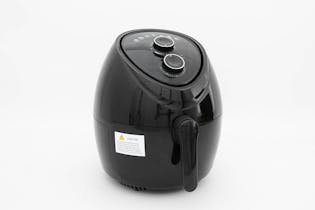Air fryers
Find the best air fryer for your home with our buying guide and test results for 42 current and 20 discontinued models.
If you’re trying to eat more healthily, consider an air fryer. They circulate hot, dry air to produce crispy food, avoiding the extra kilojoules and saturated fats you get from deep-frying.
How does an air fryer work?
An air fryer is basically a mini benchtop oven with a drawer (or sometimes a rotating basket) inside. An element and a fan circulate hot air around the food. Calling this a ‘fryer’ is pushing it a little as there really isn’t much frying happening, more baking really! Basic models will have just a timer and temperature control, but more expensive models will have preset cooking functions as well.
Do you need an air fryer?
If you already have an oven, cooktop and grill, you probably don’t need an air fryer. You can do just as good a job in your oven using little or no oil. However, an air fryer may be useful if you are a single person or couple and don’t need to cook a larger family meal. There are bigger models with dual drawers that can cook larger meals though. Some models can even cook whole chickens, but you would still need another appliance to cook the rest of the meal.
Air fryers are pretty good at making snacks as well. For suggestions on how to use an air fryer, read our ‘air fryer diary’ article I spent a week with an air fryer – are they worth all the hype?
Are air fryers a healthy way to cook?
There’s a huge buzz online about how air fryers are a healthy way to fry food. In reality, they are no healthier than your oven. They are certainly better than deep fat frying, but how many of us have deep fat fryers at home anyway? Ignore the marketing hype – cooking appliances are only as healthy as the food you put in them. Continually air frying and eating ultra-processed chicken nuggets is not a healthy option for anyone!
Are air fryers energy efficient and how much do they cost to run?
Cooking in an air fryer can be quicker than using a regular oven as air fryers generally heat up faster. Some models will use more energy than an oven, especially if you are cooking for longer than 30 minutes. At the extreme end of the scale, one air fryer in our test would cost nearly $30 a year if you used it for half an hour three times a week. That’s about the same as the average yearly running cost for a built-in oven that is used three times a week for an hour.

Features to consider
Cooking functions: Some models are also benchtop ovens and can roast, bake and grill. Where possible, we test these additional features by toasting bread, baking pizza, and roasting a whole chicken. The results for these tests can be found in our test results in the performance section.

Capacity: Some air fryers can only take 800g, so you might need to cook food in batches, or buy a larger size (at least 8L) if you plan on roasting a whole chicken or have a large household to feed.
Drawers and shelves: The majority of models use drawers, but some also have internal shelves which allow more food to be cooked. There are also a few models with doors and pull out shelves which may be more convenient, and even models with two drawers to allow cooking of two different foods at the same time.
Size: Air fryers can take up quite a bit of space on your bench or in a cupboard.
Temperature range and settings: Some air fryers don’t get hotter than 200°C or have pre-determined temperature settings.
Pans, baskets and paddles: Dishwasher-safe, non-stick coatings are easy to clean but can get scratched. Ceramic pans are also easy to clean but can chip.
Accessories: Check what equipment is included, as having to buy accessories (such as a grill rack or tongs) will bump the price up.
Viewing window or lid: Useful for checking food while it’s cooking.
Safety features: A timer and a timer cut-out (where the element turns off, but the fan stays on) are helpful, as is an overheat cut-out. Non-slip feet are a good idea if you have children – a secure grip will make it harder for a child to pull the fryer over. Also, handles on the pan make lifting it easier than trying to grab the sides with oven mitts.
Design: Air fryers can be odd looking products, many resembling small plastic barrels. Something to consider when deciding what will look good in your kitchen.
Air fryers vs multi-cookers: Multi-cookers provide many cooking functions in one, such as slow cooking, pressure cooking and steaming. There are some multi cookers that also provide air frying functionality to create crisper foods. Our tests for multi-cookers can be found here.

We've tested 62 air fryers.
Find the right one for you.
Anko
.jpg&w=315&q=75)
Anko

Anko
.jpg&w=315&q=75)